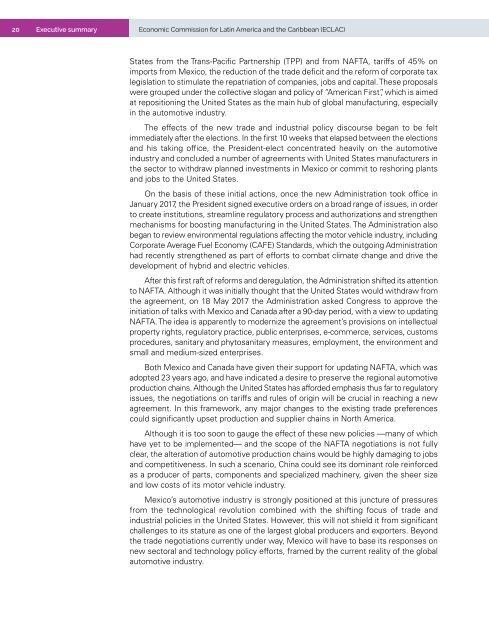Foreign Direct Investment in Latin America and the Caribbean 2017
This publication sets out and analyses the main foreign direct investment (FDI) trends in the countries of Latin America and the Caribbean. The 2017 edition shows that the region is at a difficult juncture. FDI inflows declined by 7.9% in 2016, to US$ 167.043 billion, representing a cumulative fall of 17.0% since the peak in 2011. The fall in commodity prices continues to affect investments in natural resources, sluggish economic growth in several countries has slowed the flow of market-seeking capital, and the global backdrop of technological sophistication and expansion of the digital economy has concentrated transnational investments in developed economies.
This publication sets out and analyses the main foreign direct investment (FDI) trends in the countries of Latin America and the Caribbean. The 2017 edition shows that the region is at a difficult juncture. FDI inflows declined by 7.9% in 2016, to US$ 167.043 billion, representing a cumulative fall of 17.0% since the peak in 2011. The fall in commodity prices continues to affect investments in natural resources, sluggish economic growth in several countries has slowed the flow of market-seeking capital, and the global backdrop of technological sophistication and expansion of the digital economy has concentrated transnational investments in developed economies.
You also want an ePaper? Increase the reach of your titles
YUMPU automatically turns print PDFs into web optimized ePapers that Google loves.
20 Executive summary<br />
Economic Commission for Lat<strong>in</strong> <strong>America</strong> <strong>and</strong> <strong>the</strong> <strong>Caribbean</strong> (ECLAC)<br />
States from <strong>the</strong> Trans-Pacific Partnership (TPP) <strong>and</strong> from NAFTA, tariffs of 45% on<br />
imports from Mexico, <strong>the</strong> reduction of <strong>the</strong> trade deficit <strong>and</strong> <strong>the</strong> reform of corporate tax<br />
legislation to stimulate <strong>the</strong> repatriation of companies, jobs <strong>and</strong> capital. These proposals<br />
were grouped under <strong>the</strong> collective slogan <strong>and</strong> policy of “<strong>America</strong>n First”, which is aimed<br />
at reposition<strong>in</strong>g <strong>the</strong> United States as <strong>the</strong> ma<strong>in</strong> hub of global manufactur<strong>in</strong>g, especially<br />
<strong>in</strong> <strong>the</strong> automotive <strong>in</strong>dustry.<br />
The effects of <strong>the</strong> new trade <strong>and</strong> <strong>in</strong>dustrial policy discourse began to be felt<br />
immediately after <strong>the</strong> elections. In <strong>the</strong> first 10 weeks that elapsed between <strong>the</strong> elections<br />
<strong>and</strong> his tak<strong>in</strong>g office, <strong>the</strong> President-elect concentrated heavily on <strong>the</strong> automotive<br />
<strong>in</strong>dustry <strong>and</strong> concluded a number of agreements with United States manufacturers <strong>in</strong><br />
<strong>the</strong> sector to withdraw planned <strong>in</strong>vestments <strong>in</strong> Mexico or commit to reshor<strong>in</strong>g plants<br />
<strong>and</strong> jobs to <strong>the</strong> United States.<br />
On <strong>the</strong> basis of <strong>the</strong>se <strong>in</strong>itial actions, once <strong>the</strong> new Adm<strong>in</strong>istration took office <strong>in</strong><br />
January <strong>2017</strong>, <strong>the</strong> President signed executive orders on a broad range of issues, <strong>in</strong> order<br />
to create <strong>in</strong>stitutions, streaml<strong>in</strong>e regulatory process <strong>and</strong> authorizations <strong>and</strong> streng<strong>the</strong>n<br />
mechanisms for boost<strong>in</strong>g manufactur<strong>in</strong>g <strong>in</strong> <strong>the</strong> United States. The Adm<strong>in</strong>istration also<br />
began to review environmental regulations affect<strong>in</strong>g <strong>the</strong> motor vehicle <strong>in</strong>dustry, <strong>in</strong>clud<strong>in</strong>g<br />
Corporate Average Fuel Economy (CAFE) St<strong>and</strong>ards, which <strong>the</strong> outgo<strong>in</strong>g Adm<strong>in</strong>istration<br />
had recently streng<strong>the</strong>ned as part of efforts to combat climate change <strong>and</strong> drive <strong>the</strong><br />
development of hybrid <strong>and</strong> electric vehicles.<br />
After this first raft of reforms <strong>and</strong> deregulation, <strong>the</strong> Adm<strong>in</strong>istration shifted its attention<br />
to NAFTA. Although it was <strong>in</strong>itially thought that <strong>the</strong> United States would withdraw from<br />
<strong>the</strong> agreement, on 18 May <strong>2017</strong> <strong>the</strong> Adm<strong>in</strong>istration asked Congress to approve <strong>the</strong><br />
<strong>in</strong>itiation of talks with Mexico <strong>and</strong> Canada after a 90-day period, with a view to updat<strong>in</strong>g<br />
NAFTA. The idea is apparently to modernize <strong>the</strong> agreement’s provisions on <strong>in</strong>tellectual<br />
property rights, regulatory practice, public enterprises, e-commerce, services, customs<br />
procedures, sanitary <strong>and</strong> phytosanitary measures, employment, <strong>the</strong> environment <strong>and</strong><br />
small <strong>and</strong> medium-sized enterprises.<br />
Both Mexico <strong>and</strong> Canada have given <strong>the</strong>ir support for updat<strong>in</strong>g NAFTA, which was<br />
adopted 23 years ago, <strong>and</strong> have <strong>in</strong>dicated a desire to preserve <strong>the</strong> regional automotive<br />
production cha<strong>in</strong>s. Although <strong>the</strong> United States has afforded emphasis thus far to regulatory<br />
issues, <strong>the</strong> negotiations on tariffs <strong>and</strong> rules of orig<strong>in</strong> will be crucial <strong>in</strong> reach<strong>in</strong>g a new<br />
agreement. In this framework, any major changes to <strong>the</strong> exist<strong>in</strong>g trade preferences<br />
could significantly upset production <strong>and</strong> supplier cha<strong>in</strong>s <strong>in</strong> North <strong>America</strong>.<br />
Although it is too soon to gauge <strong>the</strong> effect of <strong>the</strong>se new policies —many of which<br />
have yet to be implemented— <strong>and</strong> <strong>the</strong> scope of <strong>the</strong> NAFTA negotiations is not fully<br />
clear, <strong>the</strong> alteration of automotive production cha<strong>in</strong>s would be highly damag<strong>in</strong>g to jobs<br />
<strong>and</strong> competitiveness. In such a scenario, Ch<strong>in</strong>a could see its dom<strong>in</strong>ant role re<strong>in</strong>forced<br />
as a producer of parts, components <strong>and</strong> specialized mach<strong>in</strong>ery, given <strong>the</strong> sheer size<br />
<strong>and</strong> low costs of its motor vehicle <strong>in</strong>dustry.<br />
Mexico’s automotive <strong>in</strong>dustry is strongly positioned at this juncture of pressures<br />
from <strong>the</strong> technological revolution comb<strong>in</strong>ed with <strong>the</strong> shift<strong>in</strong>g focus of trade <strong>and</strong><br />
<strong>in</strong>dustrial policies <strong>in</strong> <strong>the</strong> United States. However, this will not shield it from significant<br />
challenges to its stature as one of <strong>the</strong> largest global producers <strong>and</strong> exporters. Beyond<br />
<strong>the</strong> trade negotiations currently under way, Mexico will have to base its responses on<br />
new sectoral <strong>and</strong> technology policy efforts, framed by <strong>the</strong> current reality of <strong>the</strong> global<br />
automotive <strong>in</strong>dustry.


















